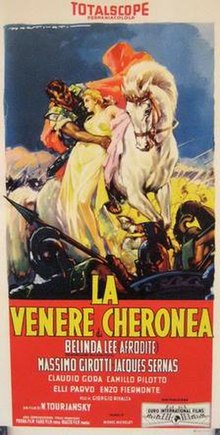
Praxiteles of Athens, the son of Cephisodotus the Elder, was the most renowned of the Attic sculptors of the 4th century BC. He was the first to sculpt the nude female form in a life-size statue. While no indubitably attributable sculpture by Praxiteles is extant, numerous copies of his works have survived; several authors, including Pliny the Elder, wrote of his works; and coins engraved with silhouettes of his various famous statuary types from the period still exist.

Belinda Lee was an English actress.

The Aphrodite of Knidos was an Ancient Greek sculpture of the goddess Aphrodite created by Praxiteles of Athens around the 4th century BC. It was one of the first life-sized representations of the nude female form in Greek history, displaying an alternative idea to male heroic nudity. Praxiteles' Aphrodite was shown nude, reaching for a bath towel while covering her pubis, which, in turn leaves her breasts exposed. Up until this point, Greek sculpture had been dominated by male nude figures. The original Greek sculpture is no longer in existence; however, many Roman copies survive of this influential work of art. Variants of the Venus Pudica are the Venus de' Medici and the Capitoline Venus.

The Venus de' Medici or Medici Venus is a 1.53 m tall Hellenistic marble sculpture depicting the Greek goddess of love Aphrodite. It is a 1st-century BC marble copy, perhaps made in Athens, of a bronze original Greek sculpture, following the type of the Aphrodite of Knidos, which would have been made by a sculptor in the immediate Praxitelean tradition, perhaps at the end of the century. It has become one of the navigation points by which the progress of the Western classical tradition is traced, the references to it outline the changes of taste and the process of classical scholarship. It is housed in the Uffizi Gallery, Florence, Italy.
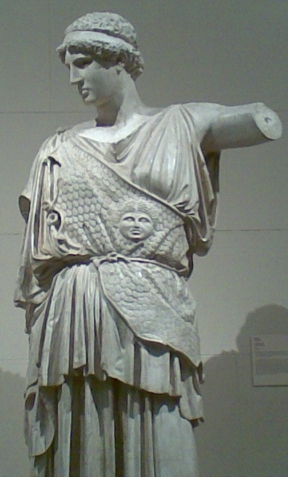
The Lemnian Athena, or Athena Lemnia, was a classical Greek statue of the goddess Athena. According to geographer Pausanias (1.28.2), the original bronze cast was created by the sculptor Phidias circa 450–440 BCE, for Athenians living on the island of Lemnos to dedicate on the Acropolis of Athens.

The Capitoline Venus is a type of statue of Venus, specifically one of several Venus Pudica types, of which several examples exist. The type ultimately derives from the Aphrodite of Cnidus. The Capitoline Venus and her variants are recognisable from the position of the arms—standing after a bath, Venus begins to cover her breasts with her right hand, and her groin with her left hand.

Massimo Girotti was an Italian film actor whose career spanned seven decades.

The Iron Crown is a 1941 Italian adventure film written and directed by Alessandro Blasetti, starring Massimo Girotti and Gino Cervi. The narrative revolves a sacred iron crown and a king who is prophesied to lose his kingdom to his nephew. It blends motifs from several European myths, legends and modern works of popular fiction. The film won a Coppa Mussolini award, which is the ancestor to the Golden Lion.

Eirene or Irene, more commonly known in English as Peace, is one of the Horae, the personification and goddess of peace in Greek mythology and ancient religion. She was depicted in art as a beautiful young woman carrying a cornucopia, sceptre, and a torch or rhyton. She is usually said to be the daughter of Zeus and Themis and thus sister of Dike and Eunomia. Her Roman equivalent is the goddess Pax.
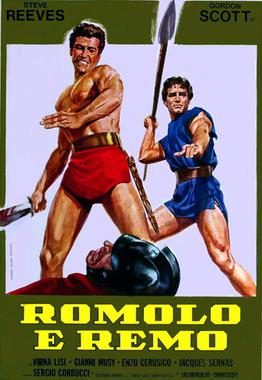
Duel of the Titans is a 1961 Italian / French film directed by Sergio Corbucci and starring Steve Reeves, Gordon Scott, and Virna Lisi. The film is about twin brothers revolt against tyranny in pre-Roman Italy and then come to a parting of the ways as they lead their people toward the founding of a new city, known as Rome. This is based on the legend of Romulus and Remus.
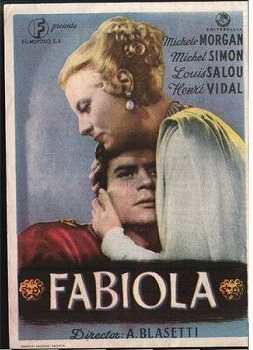
Fabiola is a 1949 Italian language motion picture historical drama directed by Alessandro Blasetti, very loosely based on the 1854 novel Fabiola by Nicholas Patrick Wiseman. The film stars Michèle Morgan, Henri Vidal and Michel Simon. It tells the story of the Roman Empire in which Christianity is growing around the 4th century AD. An unofficial remake, The Revolt of the Slaves, was released in 1960, with Lang Jeffries and Rhonda Fleming, only with Rhual's name changed to Vibio.

Sheba and the Gladiator or Sign of the Gladiator is a 1959 historical drama film loosely pertaining to the Palmyrene Empire and its re-annexation back into the Roman Empire.

Constantine and the Cross is a 1961 historical drama film about the early career of the emperor Constantine, who first legalized and then adopted Christianity in the early 4th century. The fictionalised film only stretches as far into his life as the Battle of the Milvian Bridge in AD 312.
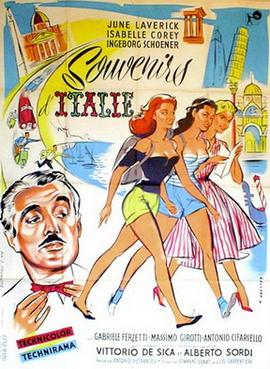
Souvenirs d'Italie is a 1957 Italian film. It stars actor Gabriele Ferzetti.

The Shortest Day is a 1963 Italian comedy film. It is a parody of the war movie The Longest Day and stars the popular duo Franco and Ciccio in the leading roles. Dozens of other well-known actors, from both European and American cinema, agreed to appear in the movie in cameo roles for free to avert the bankruptcy of the production company, Titanus.

Aphrodite: mœurs antiques is an 1896 French-language novel by Pierre Louÿs.

The Diana of Gabii is a statue of a woman in drapery which probably represents the goddess Artemis and is traditionally attributed to the sculptor Praxiteles. It became part of the Borghese collection and is now conserved in the Louvre with the inventory number Ma 529.

Slave Women of Corinth is a 1958 Italian epic historical drama film written and directed by Mario Bonnard.

La trovatella di Pompei is a 1957 Italian melodrama film co-written and directed by Giacomo Gentilomo and starring Massimo Girotti and Alessandra Panaro.

The Nights of Lucretia Borgia is a 1959 Italian historical drama film. It was also known as Le notti di Lucrezia Borgia and Nights of Temptation. It was one of a series of sexually aggressive characters Belinda Lee played in European movies.
